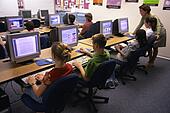Additionally it depends on how computers are incorporated into the early childhood curriculum (Haugland, 2000). Te Whariki believe that children develop familiarity with properties and character of the materials and technology used in the creative and expressive arts (Ministry of Education, 1996). As an early childhood educator, I believe that children should be expose in creative activity such as painting, music, drawing or collage as their way of expressing themselves. Documenting children's work with a nice photo done by a digital camera is so easy that the children can take turn taking photo of themselves.
Most experts believe computers are not developmentally appropriate for children under the age of three (Elkind, 1998; Haugland, 1999; NAEYC, 1996). However, these same experts believe children three years old and older can begin to effectively explore and use computers. Surely, many of the factors that make computers developmentally inappropriate for children under age three are also present in older children: active learners busily manipulating a wide variety of objects…and in the process of learning about themselves and their environment” (Haugland, 1999, p. 26).
Te Whariki affirms that children develop spatial understandings, including an awareness of how two-and three dimentional objects can be fitted together and moved in space and ways in which spatial information can be represented, such as in maps, diagrams,photographs and drawings (Ministry of Education, 1996).
To evaluate whether computers are developmentally appropriate for children over age three, we need to determine the developmental needs of these children. Children this age are developmentally within Piaget’s preoperational stage. This means they are concrete learners who are very interested in using newly learned symbolic representation - speaking, writing, drawing (including maps and geometric figures) and using numbers. Further, children this age are extremely active and movable. They often have difficulty sitting still; they need frequent changes in learning modalities; and they want a variety of physical experiences involving dance, physical play, climbing and sports.
Preoperational children are also are continuing their mastery of language, and exploring various facets of social behavior.Howard Gardner has shown that young children exhibit a diversity of learning styles, and that the optimum way for many children to learn is not the traditional teacher-directed, verbal approach (
Clearly many of these developmental needs match up well with appropriate use of technology in the centre, especially exploration, manipulation of symbolic representation, matching alternative learning styles, and quickly changing learning modalities that individual children can control and pace to meet their individual needs. It is also a very powerful tool for children with specific learning disabilities.
If a goal of the literacy curricula for a certain age child is to learn to write personal journals, then the computer can naturally support that through writing software, digital cameras, and other methods.
If computers are not fully integrated into the overall curriculum, they can actually negatively impact children’s creativity (Haugland, 1997). To integrate computers effectively, these steps must occur:
select developmentally appropriate software; select developmentally appropriate websites and Integrate computer resources in the centre.
select developmentally appropriate software; select developmentally appropriate websites and Integrate computer resources in the centre.
So there, technology is here to stay its changing fast and theres nothing we can do about it, but to welcome and learn it......... FAST




References:




References:
Elkind, D. (1998). Computers for infants and young children. Child Care Information Exchange. 123, 44-46.
Haugland, S. W. (2000). Early childhood classrooms in the 21st century: Using computers to maximize learning. Young Children, 55 (1), 12-18.
Haugland, S. W. (1999). What role should technology play in young children’s learning? Young Children, 54 (9), 26- 30)..
Ministry of Education. (1996) Te whāriki, he whāriki mātauranga mō ngā Mokopuna o Aotearoa: Early childhood curriculum. Wellington, New Zealand: Learning Media.
NAEYC (1996). Position statement on technology and young children - ages three through eight. Young Children, 51 (6), 11-16.
Haugland, S. W. (1997). The developmental scale of software. Cape Girardeau, MO: K.I.D.S. & Computers.
Gardner, H. (1987). Frames of mind: The theory of multiple intelligences. New York: Basic.